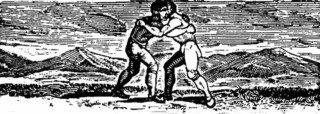Cross-Buttock, Hank and Hipe
Miranda Vane
‘There are people,’ Roland Barthes wrote, ‘who think that wrestling is an ignoble sport.’ It is possible that those who put together the recent successful nomination to make the Lake District a Unesco World Heritage Site are just such people. The bid made much of the paintings and poems inspired by the landscape, but gave little attention to Cumberland and Westmorland Wrestling, which was said by Sir Walter Armstrong in 1890 to be ‘productive of the most unparalleled excitement in the Northern counties’.
A Thomas Bewick woodcut, thought to have been produced in 1776, shows two wrestlers engaged in the distinctive C&W back-hold, evidence that the sport has been practised in its current form since at least then, though wrestling had been popular across the region since long before. The most frequently occurring sport in medieval misericords, it is occasionally found carved into ninth-century Irish crosses. But some people argue that it is a legacy of Viking invaders, like many local place names and the particularities of Cumbrian dialects.
A 1656 edict from Oliver Cromwell’s Associated Ministers and Churches of the Counties of Cumberland and Westmorland includes wrestling on a list of sinful amusements that would lead to any perpetrator being ‘suspended from the Sacrament of the Lord’s Supper’. Prohibition failed but moral concern about wrestling endured. Professor John Wilson, writing under the pen name Christopher North in Blackwood’s Magazine in December 1823, voiced his consternation that such was the mania for wrestling, ‘we fear it is thought of even in church.’ History doesn’t relate if this was a problem for Rev. Osborne Littledale, an early 19th-century curate of Buttermere, who once took first place in the wrestling at the Crab Tree sports in Egremont; his clerk came first in the fell running. The Rev. Abraham Brown, another noted clerical champion, was said in 1823 to be the first C&W wrestler ‘of whom we have authentic records of excellency as a “buttocker”’.
Buttocking is a ‘chip’ (as C&W moves are known) in which a wrestler ‘grasses’ his opponent by getting his back under his stomach and throwing him over his head. A bout begins with wrestlers ‘tekking hod’: clasping their hands around one another’s back, chins resting on each other’s right shoulder. Once the contest is underway, a wrestler, without breaking their hold, may employ any of a number of chips to fell their adversary; the less showy cross-buttock, or the ‘barbarous and unscientific’ hank, or the swinging hipe.
The traditional C&W strip (an anachronistic remnant of 1860s sporting fashion) consists of vest, leggings and stockinged feet, with velvet briefs worn outside of the leggings, Superman-style. It is customary for the outfits to be embroidered with flowers, birds and butterflies, and in many tournaments the wrestling is preceded by a costume competition.
William Wordsworth wasn’t a fan. Writing to protest against the opening of the Kendal to Windermere railway, he complained that wrestling was devised by the directors of railway companies to lure ‘the imperfectly educated classes’ to travel by train to the Lakes, only to be parted from their meagre wages by frivolous distractions.
Charles Dickens, however, was rather taken with the sport. He found watching wrestling in the saw-dust circles and gas lights of St John’s Wood ‘wearisome to the last degree’, but was so captivated by ‘the vigour of sinew, the shifts of suppleness’ at the Ferry Ring on Windermere that he took a lesson with the 1858 champion, ‘Bonnie’ Longmire. His schooling, which took place in the wrestler’s garden, ‘has left [its] mark indelibly in our back’, he wrote in Household Words, ‘besides having compressed our ribs so that we cannot breathe right yet’.
C&W wrestling is no longer as popular as it once was. A coach recently said that he was losing his protégés to the lure of ‘prosperity and a fine career south of the Watford Gap’. Leaving home did not always preclude a wrestling career. From 1824, the now defunct C&W Wrestling Society would meet on Kennington Common on Good Friday. It doesn’t seem to have caught on with Londoners. An article in the Pall Mall Gazette in 1864 reporting on a C&W wrestling match at the Agricultural Hall in Islington noted with suspicion the ‘infusion of provincial gentlemen with a marked North Country accent’, smoking inferior tobacco and betting with ‘an unnecessary amount of vociferation’.
Shortly before the general election of 1820, Wilson wrote in Blackwood’s, a friend of his returned home to London from Cumberland perplexed that, as far as he could establish, the county was not to be contested by Lord Lowther and Henry Brougham as it was widely understood in London, but by Thomas Ford of Egremont, and William Richardson of Caldbeck, ‘men of no landed property and probably Radicals’. In the event, Viscount Lowther retained his seat and William Richardson, a legendary wrestler of 14 stone, won the great annual wrestling contest at Carlisle.
